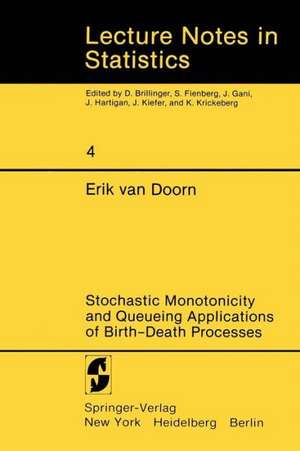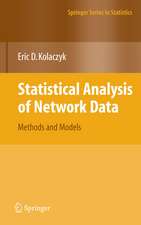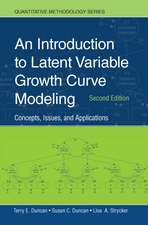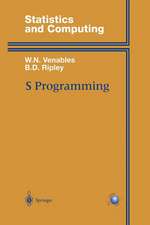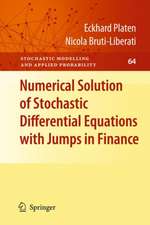Stochastic Monotonicity and Queueing Applications of Birth-Death Processes: Lecture Notes in Statistics, cartea 4
Autor Erik van Doornen Limba Engleză Paperback – 20 feb 1981
Din seria Lecture Notes in Statistics
- 15%
 Preț: 631.86 lei
Preț: 631.86 lei -
 Preț: 385.84 lei
Preț: 385.84 lei - 17%
 Preț: 490.20 lei
Preț: 490.20 lei - 17%
 Preț: 460.30 lei
Preț: 460.30 lei - 18%
 Preț: 945.92 lei
Preț: 945.92 lei - 20%
 Preț: 561.44 lei
Preț: 561.44 lei - 18%
 Preț: 943.25 lei
Preț: 943.25 lei - 18%
 Preț: 943.25 lei
Preț: 943.25 lei - 18%
 Preț: 990.57 lei
Preț: 990.57 lei - 15%
 Preț: 641.38 lei
Preț: 641.38 lei -
 Preț: 428.67 lei
Preț: 428.67 lei - 15%
 Preț: 633.53 lei
Preț: 633.53 lei - 15%
 Preț: 658.88 lei
Preț: 658.88 lei -
 Preț: 383.33 lei
Preț: 383.33 lei - 15%
 Preț: 640.71 lei
Preț: 640.71 lei - 18%
 Preț: 947.18 lei
Preț: 947.18 lei - 18%
 Preț: 1007.35 lei
Preț: 1007.35 lei - 18%
 Preț: 942.63 lei
Preț: 942.63 lei - 15%
 Preț: 639.59 lei
Preț: 639.59 lei - 18%
 Preț: 1231.47 lei
Preț: 1231.47 lei - 15%
 Preț: 643.00 lei
Preț: 643.00 lei - 18%
 Preț: 886.62 lei
Preț: 886.62 lei -
 Preț: 383.12 lei
Preț: 383.12 lei - 15%
 Preț: 633.35 lei
Preț: 633.35 lei - 15%
 Preț: 635.65 lei
Preț: 635.65 lei -
 Preț: 393.74 lei
Preț: 393.74 lei - 15%
 Preț: 632.70 lei
Preț: 632.70 lei - 15%
 Preț: 637.28 lei
Preț: 637.28 lei - 15%
 Preț: 702.87 lei
Preț: 702.87 lei - 15%
 Preț: 642.68 lei
Preț: 642.68 lei - 15%
 Preț: 644.63 lei
Preț: 644.63 lei - 15%
 Preț: 645.14 lei
Preț: 645.14 lei -
 Preț: 382.36 lei
Preț: 382.36 lei - 15%
 Preț: 636.30 lei
Preț: 636.30 lei - 15%
 Preț: 647.92 lei
Preț: 647.92 lei -
 Preț: 380.63 lei
Preț: 380.63 lei - 18%
 Preț: 887.05 lei
Preț: 887.05 lei - 15%
 Preț: 634.32 lei
Preț: 634.32 lei - 15%
 Preț: 648.74 lei
Preț: 648.74 lei -
 Preț: 378.92 lei
Preț: 378.92 lei - 15%
 Preț: 648.56 lei
Preț: 648.56 lei - 15%
 Preț: 647.59 lei
Preț: 647.59 lei - 18%
 Preț: 780.37 lei
Preț: 780.37 lei - 15%
 Preț: 641.20 lei
Preț: 641.20 lei - 18%
 Preț: 1102.69 lei
Preț: 1102.69 lei - 15%
 Preț: 643.16 lei
Preț: 643.16 lei -
 Preț: 384.70 lei
Preț: 384.70 lei
Preț: 378.34 lei
Nou
Puncte Express: 568
Preț estimativ în valută:
72.40€ • 77.42$ • 60.36£
72.40€ • 77.42$ • 60.36£
Carte tipărită la comandă
Livrare economică 18 aprilie-02 mai
Preluare comenzi: 021 569.72.76
Specificații
ISBN-13: 9780387905471
ISBN-10: 0387905472
Pagini: 118
Ilustrații: VI, 118 p.
Dimensiuni: 155 x 235 x 7 mm
Greutate: 0.19 kg
Ediția:Softcover reprint of the original 1st ed. 1981
Editura: Springer
Colecția Springer
Seria Lecture Notes in Statistics
Locul publicării:New York, NY, United States
ISBN-10: 0387905472
Pagini: 118
Ilustrații: VI, 118 p.
Dimensiuni: 155 x 235 x 7 mm
Greutate: 0.19 kg
Ediția:Softcover reprint of the original 1st ed. 1981
Editura: Springer
Colecția Springer
Seria Lecture Notes in Statistics
Locul publicării:New York, NY, United States
Public țintă
ResearchCuprins
1 : Preliminaries.- 1.1 Markov processes.- 1.2 Stochastic monotonicity.- 1.3 Birth-death processes.- 1.4 Some notation and terminology.- 2 : Natural Birth-Death Processes.- 2.1 Some basic properties.- 2.2 The spectral representation.- 2.3 Exponential ergodicity.- 2.4 The moment problem and related topics.- 3 : Dual Birth-Death Processes.- 3.1 Introduction.- 3.2 Duality relations.- 3.3 Ergodic properties.- 4 : Stochastic Monotonicity: General Results.- 4.1 The case ?0 = 0.- 4.2 The case ?0 > 0.- 4.3 Properties of E(t).- 5 : Stochastic Monotonicity: Dependence on the Initial State Distribution.- 5.1 Introduction to the case of a fixed initial state.- 5.2 The transient and null recurrent process.- 5.3 The positive recurrent process.- 5.4 The case of an initial state distribution with finite support.- 6 : The M/M/S Queue Length Process.- 6.1 Introduction.- 6.2 The spectral function.- 6.3 Stochastic monotonicity.- 6.4 Exponential ergodicity.- 7 : A Queueing Model Where Potential Customers are Discouraged by Queue Length.- 7.1 Introduction.- 7.2 The spectral representation.- 7.3 Stochastic monotonicity and exponential ergodicity.- 8 : Linear Growth Birth-Death Processes.- 8.1 Introduction.- 8.2 Stochastic monotonicity.- 9 : The Mean of Birth-Death Processes.- 9.1 Introduction.- 9.2 Representations.- 9.3 Sufficient conditions for finiteness.- 9.4 Behaviour of the mean in special cases.- 10 : The Truncated Birth-Death Process.- 10.1 Introduction.- 10.2 Preliminaries.- 10.3 The sign structure of P’(t).- 10.4 Stochastic monotonicity.- Appendix 1 : Proof of the Sign Variation Diminishing Property of Strictly Totally Positive Matrices.- Appendix 2: On Products of Infinite Matrices.- Appendix 3: On the Sign of Certain Quantities.- Appendix 4: Proof of Theorem 10.2.8.-References.- Notation Index.- Author Index.
